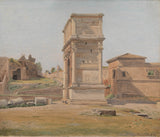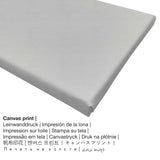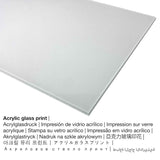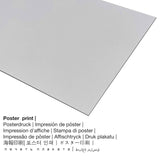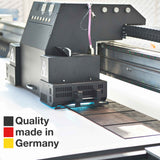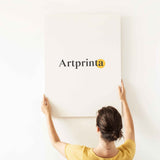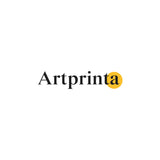Constantin Hansen, 1839 - Arch nke Taịtọs dị na Rome - mbipụta nka mara mma
Ụtụ gụnyere. Mbupu gbakọrọ na ndenye ọpụpụ.
Ihe omuma ihe omuma
Ihe nka nka The Arch of Titus in Rome bụ onye omenkà romanticist kere Constantin Hansen. Ụdị nke mpempe nka na-atụ nha nha 24 × 29 cm (9,4 × 11,4 ″) e were kwa ihe-ọcha tee ya mmanụ. Moveover, the artwork is in the the Statens Museum for Kunst (National Gallery of Denmark)'s collection, which is the largest museum of fine arts in Denmark and is attached to the Danish Ministry of Culture.. With courtesy of - Statens Museum for Kunst & Wikimedia Commons (ọha na eze).Ebe E Si Nweta nke ihe osise:. Ọzọkwa, itinye n'ọnọdụ odida obodo format ma nwee akụkụ nke 1.2: 1, nke pụtara na ogologo bụ 20% ogologo karịa obosara. Constantin Hansen was a male painter, whose art style can be classified as Romanticism. The Danish artist was born in the year 1804 na Rome, Rome Province, Lazio, Italy ma nwụọ mgbe ọ dị afọ 76 n'afọ 1880.
Nkọwa ahaziri nke ọrụ nka
| Aha nke ihe nka: | "Akụkụ nke Taịtọs dị na Rom" |
| Nhazi nka nka: | sere |
| Category: | nkà nke oge a |
| Century: | 19th narị afọ |
| Afọ okike: | 1839 |
| Ogologo afọ nka nka: | gbara afọ 180 |
| Usoro izizi: | mmanụ |
| Akụkụ nke nka nka izizi: | 24 × 29 cm (9,4 × 11,4 ″) |
| Ụlọ ihe ngosi nka / mkpokọta: | Statens Museum maka Kunst (National Gallery nke Denmark) |
| Ebe ngosi nka: | Copenhagen, Denmark |
| Dị n'okpuru: | www.smk.dk |
| Ikikere nke ihe osise: | ngalaba ọha |
| Site n'aka: | Statens Museum maka Kunst & Wikimedia Commons |
Banyere onye na-ese ihe
| Ihe nkiri: | Constantin Hansen |
| Aliases: | Constantin Hansen, Carl Christian Constantin, Hansen Constantin, Hansen Carl Christian Constantin, Hansen |
| Gender: | nwoke |
| Obodo onye nka: | Danish |
| Ọrụ nke onye na-ese ihe: | onye na-ese ihe |
| Mba onye si: | Denmark |
| nhazi ọkwa: | omenkà nke oge a |
| Ụdị nke onye na-ese ihe: | Ihunanya |
| Oge ndu: | 76 afọ |
| Afọ ọmụmụ: | 1804 |
| Ebe amụrụ onye: | Rome, Rome Province, Lazio, Italy |
| Afọ nwụrụ: | 1880 |
| Ebe ọnwụ: | Frederiksberg, Sj?lland, Denmark |
Họrọ ihe ị ga-achọ ka kpọgidere na mgbidi gị
Na nhọrọ mwepu ngwaahịa ị nwere ike họrọ ngwa na nha nke gị. Ị nwere ike ịhọrọ n'ime nhọrọ nhazi ngwaahịa ndị a:
- Mbipụta kwaaji: The printed canvas material stretched on a wooden frame. A canvas has the particular look of three-dimensionality. Your canvas of this artwork will give you the opportunity to transform your into a large artpiece like you would see in a true gallery. Canvas Prints have the great advantage of being low in weight, which means that it is easy to hang the Canvas print without the use of extra wall-mounts. Hence, canvas prints are suited for all types of walls.
- Glass acrylic e biri ebi (nwere ezigbo mkpuchi iko): The acrylic glass print, often referenced as a print on plexiglass, will transform the original into wall decoration. In addition, it is a viable alternative option to canvas and dibond fine art replicas. The work of art is printed with the help of modern UV direct printing technology. The major advantage of an acrylic glass art print is that contrasts plus smaller painting details become more recognizeable with the help of the delicate tonal gradation.
- Mpempe akwụkwọ mmado ebipụtara na akwa akwa: Our poster is a printed flat canvas paper with a fine structure on the surface. The poster print is particularly appropriate for framing the art copy in a custom frame. Please note, that depending on the absolute size of the poster we add a white margin of approximately 2 - 6cm round about the print motif in order to facilitate the framing with a custom frame.
- Mbipụta ọla (aluminium dibbond): Aluminium Dibond prints are metal prints with a true depth effect. A direct Direct Print on Aluminum Dibond is your ideal introduction to the sophisticated world of replicas made with aluminum. For our Direct Aluminium Dibond option, we print your favorite work of art right onto the surface of the aluminum. The white & bright parts of the original work of art shimmer with a silk gloss, however without the glare.
Nkọwa ngwaahịa
| Ụdị ngwaahịa: | nka nka |
| Mmeputakwa: | mmeputakwa n'ụdị dijitalụ |
| Usoro mmepụta: | mbipụta dijitalụ (Mbipụta UV ozugbo) |
| Production: | arụpụtara na Germany |
| Ụdị ngwaahịa: | a na-achọ |
| A na-atụ aro iji ngwaahịa eme ihe: | ime ụlọ, nka mgbidi |
| Nhazi nka nka: | nhazi odida obodo |
| Ụdị anya: | 1.2: 1 - ogologo: obosara |
| Akụkụ akụkụ pụtara: | ogologo bụ 20% ogologo karịa obosara |
| Akụrụngwa ị nwere ike ịhọrọ: | Mbipụta kwaaji, mbipụta enyo acrylic (nwere ezigbo mkpuchi iko), mbipụta akwụkwọ mmado (akwụkwọ kwaaji), mbipụta ọla (aluminium dibbond) |
| Mpempe akwa akwa (akwa akwa na etiti ihe ndọtị) nha: | 60x50cm - 24x20", 120x100cm - 47x39", 180x150cm - 71x59" |
| Acrylic glass print (nwere ezigbo mkpuchi iko) nhọrọ: | 60x50cm - 24x20", 120x100cm - 47x39", 180x150cm - 71x59" |
| Nhọrọ nke mbipụta akwụkwọ mmado (akwụkwọ kwaaji): | 60x50cm - 24x20", 120x100cm - 47x39" |
| Nhọrọ nha nha nke aluminom dibond (ihe aluminom): | 60x50cm - 24x20", 120x100cm - 47x39" |
| Igwe onyonyo: | adịghị |
Nkwupụta iwu: We try to describe the products as precisely as it is possible and to illustrate them visually on the product detail pages. Nonetheless, the tone of the printed materials, as well as the printing can vary marginally from the representation on your monitor. Depending on your settings of your screen and the quality of the surface, not all color pigments are printed as realisitcally as the digital version depicted here. Since our are processed and printed manually, there might also be minor variations in the motif's size and exact position.
© Nwebiisinka nke - Artprinta.com (Artprinta)

